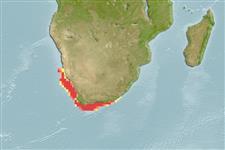Common names from other countries
Élasmobranches (requins et raies) (sharks and rays) >
Rajiformes (Skates and rays) >
Rajidae (Skates)
Etymology: Dipturus: Greek, di = two + Greek, pteryx = fin (Ref. 45335).
More on author: Smith.
Environment: milieu / climate zone / depth range / distribution range
Écologie
marin démersal; profondeur 50 - 457 m (Ref. 5578). Subtropical; 26°S - 36°S, 12°E - 29°E (Ref. 114953)
Southeast Atlantic: known only from Lüderitz, Namibia to Port Alfred, Eastern Cape (South Africa)
Taille / Poids / Âge
Maturity: Lm ? range ? - ? cm
Max length : 130 cm TL mâle / non sexé; (Ref. 114953)
Description synthétique
Clés d'identification | Morphologie | Morphométrie
A striking two-toned longnose skate, medium brown above and abruptly dark grey below, with a large, conspicuous, dark brown blotch on the upper base of each pectoral fin (Ref. 5578). Snout moderately elongated and bluntly triangular, and tail stout, not conspicuously swollen and about equal to body length; pectoral disc with broadly rounded corners and smooth underside without denticles; thorns at nape and along midline of back and tail to 1st dorsal fin, nape spine enormous in young (Ref. 5578). Hatchlings and juveniles with wide-spaced black spots on upper disc, inconspicuous or lost in adolescents and adults; adults sometimes with numerous small white spots (Ref. 5578). Underside with numerous black pores (Ref. 5578).
Found on soft bottoms of the outer shelf and upper slope (Ref. 5578). Feeds on bony fish, crabs, shrimp, mysids, mantis shrimp, euphausiids, bivalves and cuttlefish (Ref. 5578). Oviparous (Ref. 50449). Eggs have horn-like projections on the shell (Ref. 205). Males reaches maturity at 88-96 cm TL, females possibly slightly larger off Western than Southern coast of South Africa; hatching size at ca. 19 cm TL (Ref. 114953). Commonly taken by hake trawlers (Ref. 5578). Extremely slippery when caught (Ref. 5578).
Life cycle and mating behavior
Maturities | Reproduction | Spawnings | Egg(s) | Fecundities | Larves
Oviparous, paired eggs are laid. Embryos feed solely on yolk (Ref. 50449). Eggs have horn-like projections on the shell (Ref. 205).
McEachran, J.D. and K.A. Dunn, 1998. Phylogenetic analysis of skates, a morphologically conservative clade of elasmobranchs (Chondrichthyes: Rajidae). Copeia 1998(2):271-290. (Ref. 27314)
Statut dans la liste rouge de l'IUCN (Ref. 130435)
CITES (Ref. 128078)
Not Evaluated
Menace pour l'homme
Harmless
Utilisations par l'homme
Pêcheries: sans intérêt
Outils
Articles particuliers
Télécharger en XML
Sources Internet
Estimates based on models
Preferred temperature (Ref.
115969): 9.2 - 16.7, mean 11 (based on 41 cells).
Phylogenetic diversity index (Ref.
82804): PD
50 = 0.5000 [Uniqueness, from 0.5 = low to 2.0 = high].
Bayesian length-weight: a=0.00372 (0.00249 - 0.00554), b=3.20 (3.08 - 3.32), in cm Total Length, based on LWR estimates for this species & Genus-body shape (Ref.
93245).
Niveau trophique (Ref.
69278): 4.1 ±0.69 se; based on food items.
Résilience (Ref.
120179): Faible, temps minimum de doublement de population : 4,5 à 14 années (Fec assumed to be <100).
Fishing Vulnerability (Ref.
59153): Very high vulnerability (75 of 100).
